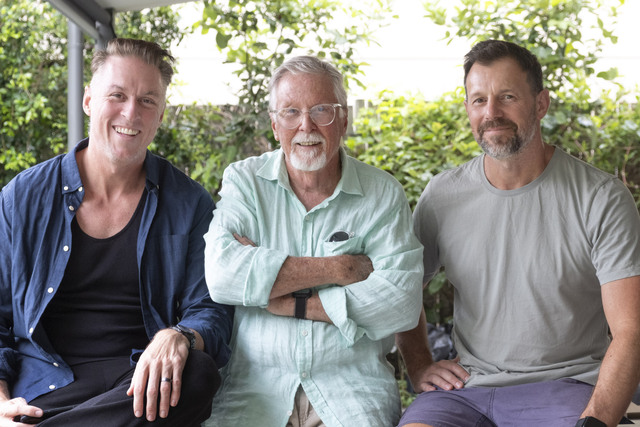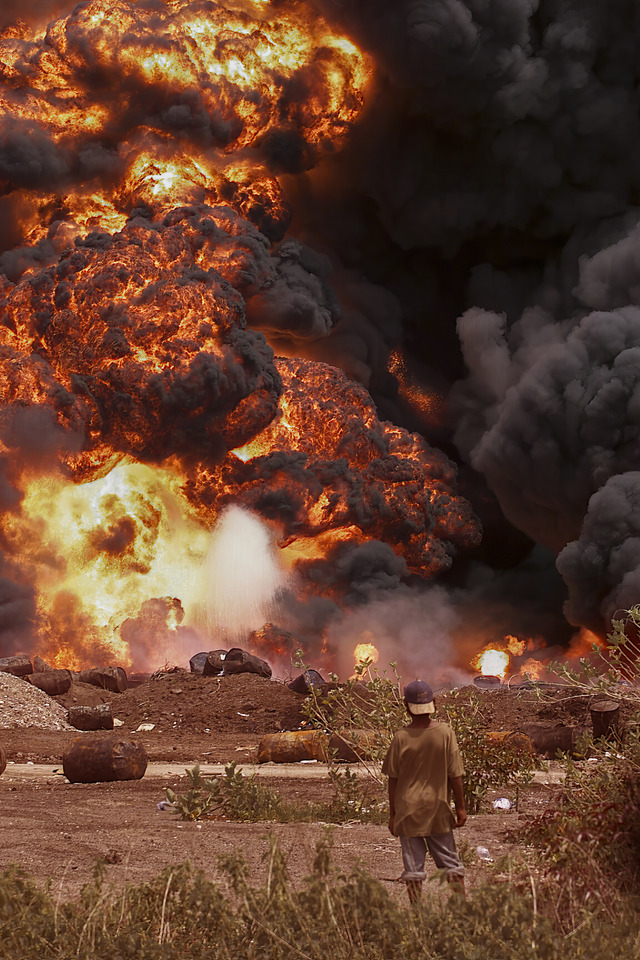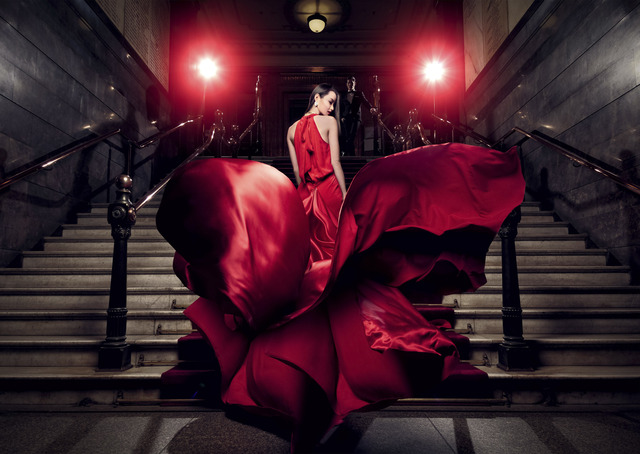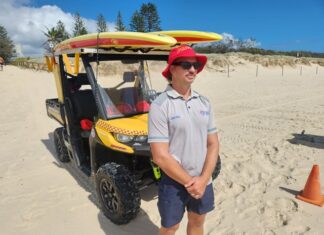We all want to know how did they achieve such amazing pieces of photography journalist, filmmaker and Powderfinger drummer Jon Coghill said as he introduced Noosa photographers Rob Maccoll and Andrew Maccoll at an artist talk at their exhibition, Dual Vision, at the Noosa Regional Gallery last Saturday.
Both artists have received numerous accolades: Rob won the Walkley Award in 2000 for his work in East Timor and the United Nations Association Media Peace Award in 2004 for his coverage of the HIV/AIDS crisis in Papua New Guinea. Andrew’s achievements include three portraits in the Australian National Portrait Gallery and recognition from Capture Magazine and the Hasselblad Masters for his incredible fashion and celebrity photography.
Here is some of that conversation.
Jon Coghill (JC): All artists probably have a moment when they realise this is what they want to do. Andy you became a very prominent fashion photography. Was there one moment?
Andrew Maccoll (AM): There’s always a turning point. For me photography, with dad, started quite young. Dad was always going overseas. One time he went to Tonga for lunch and came back with a whale tooth necklace given to him by the chief. He was always going off to these exotic locations. I just thought, that’s for me. And then I grew up I’d help him out with shoots. I think I was about 16 when I first picked up a camera. I was, like, I’m going to give this a go, as well as helping my dad at the Courier Mail. One of those shoots I really loved was fashion. You could imagine a young 16-year-old boy with a lot of models strutting around the place and these sets they used to make at the Courier Mail. I just really enjoyed the aesthetic and I think from there it carried on. I think the catalyst for me was seeing my first billboard. It was in Melbourne. Funny enough it wasn’t fashion it was for Vodka Cruiser. I think having large scale work in a public space was really validating. I started as a press photographer, followed in dad’s footsteps then decided I wanted to take fashion seriously. So I spent two years doing a portfolio on the side while I was in press. So in the days I was going to roadside accidents and the next day I’d be chasing my own work with a team of people who also wanted to do their own work, like make up artists and hairdressers. You’d need about six shoots to be taken seriously. I built a portfolio over two years. I had a big book of prints and I’d leave that at the brands or advertising agencies on purpose because I knew at some time they’d pick it up. And one day I got a call from Clemenger’s which was the biggest advertising agency in Australia at the time. The woman said you left your book here, it’s been here for a few months now, I think you’d be great for this campaign coming up. That was the moment for me because Clemengers was calling me. That was the pinnacle. That led to me doing a lot of work for them. Once you do work for them it means better budgets, more resourcing and so on.
Rob Maccoll (RM): I started working for ABC television way back in the black and white days. Then everything went out live in those days. There was nothing to put on the wall. Then a mate and I started shooting stills. You put them up on the wall. That was the first medium I was really happy with. Eventually I was made a stills photographer for ABC television and that was fantastic. Then I got a job with Foreign Affairs in Sydney with the Australian Information Service (AIS). With that I was travelling around Australia doing all these landscapes, travelling around the world doing Aid projects and then doing all the presidential and Royal tours. That meant travelling in Lear Jets and limos. You’d spend weeks with someone like Prince Phillip. It’s hard to beat that. At the end of the visit you’d put together an album, ‘This is your tour of Australia’. It’d go back to the Palace or whatever country they came from as an official record of their visit to Australia. Change of government, they decided to outsource it. We were offered a choice of a redundancy or a job in an embassy. I took a redundancy, came back to Brisbane and started freelancing. I was offered a job in the Sunday Mail. In those days there were very few colour photographers. I had a range of experience in colour. They snapped me up to shoot their colour magazine, when they had one.
JC: You ended up being a war correspondent. Let’s talk about a normal day on the job. You’re looking at one shot, two shots, a thousand shots?
RM: It’d normally be a thousand shots in a day, or maybe an hour. I was in the studio doing a fashion shoot, I got a knock on the door, the boss was there and said I want you to go to East Timor tomorrow. That was – get everything packed. I had to get a flight to Darwin and I got a Hercules to Timor. I was the only person on the Hercules with a ton of gear. I was dropped on the tarmac, pushed out the back. I had to get everything myself. Fortunately there was a Cammo (cameraman) there Harry Burton he gave me a lift into town. Everyone was staying at the burnt out Tourismo Hotel.
JC: Is this Timor? Yes, Tell me about this shot
RM: We were just coming back from a day’s shoot. A fuel dump blew up. There was no security. They were all 44gallon drums blowing up. The lids were flying off like frisbees at head height. That was a pretty typical day. This was a digital shot. This was taken on the original Canon digital press camera which was 2.5megapixels, weighed a ton and cost $35,000.
JC: How did you know this was the shot?
RM: I probably took 20-30 frames of that. I like that because you see the intensity. It got more and more intense in Timor.
At one point we were smuggled into West Timor to do a story that journalist Carmel Egan had on refugees who had fled to West Timor and got into camps run by the militia. The militia were keeping them there, weren’t providing aid. People were dying of dysentry, disease. So the UN came to
her and said can you guys go in and take some photos and do a story. So UN smuggled us in. We spent the day getting shots of people in miserable conditions. We got a pile of photos that went into papers across the world the next day and was picked up by CNN and BBC. The next day the Indonesian Government that had denied there was anyone in there admitted they were there. They finally got aid. About a year after I met a guy from the UN who said you don’t know me but I know you. You guys probably saved hundreds of lives.
JC: Andy let’s go to a day on the job. What does it take to get a rock star photo getting the way you want it do?
AM: Celebrity is quite different to fashion. The Matt Damon portrait was the first I did. I was working for a daily. I used to come in in the morning. There used to be job sheets there. If you got in early enough you could take your pick. I rifled through the list, saw Matt Damon and thought, that’s mine. The typical kit was DSLR, flash, Elinchrome flash kit. I got there half and hour early, set up, Matt Damon walks in. I sat with him. I got half an hour with him which is a long time for a celebrity. We were always told faces sold papers.
The rule is light, tight and bright – tight headshots. That was the go-to. When Matt was asked at the end of the interview what would you change if you could change anything. This was at the height of his fame, when he was doing the Bourne series. He didn’t say anything for about a minute, then he said, “I’d probably be less famous”. In that moment I was like I’m your fan.
(In relation to a shot of Nick Cave band Bad Seeds) I got a call from the boys out of the blue one day. They said we’ve been recommended. We’ve seen your work. Do you want to do the photography for our next album. There wasn’t as much planning. The fashion planning can take months. It was, what can we do to be cool and creative and give you guys a diverse range of photography for press and the album itself. There would have been around 1000 frames. Dad always told me if you doubt what you should do, just shoot the shit out of it.
JC: Celebrities, rock stars, they must be hard to deal with. There must be a trick.
AM: There is a trick. Typically I’d get five minutes with that person. They’d come in. I just treated them like they were my neighbour. I’d say, Gidday mate, have a seat. We’re just going to take a few photos. What do you feel like doing, in a conversational term. And as soon as they felt I wasn’t saying, O God I’m such a big fan, they just relaxed. Once they were relaxed I got better imagery.
JC: What are you trying to get?
AM: I want to get past the camera style. I want to capture the real person. A lot of the portraits I do I don’t typically tell people to smile. I prefer to get something real, a real connection. I find those connections come during conversation with them. It’ll be a moment I’ll ask them some question and that’s when I’ll get the shot – when they’re just being themselves.
JC: Rob, is there a moment in war when you’re trying to capture the real person?
RM: Most times you don’t have time to line things up. I’ve always hated lining things up. I would try and shoot something real, get the actual event happening. Real stories, real events. Basically you shoot it as it happens. Occasionally you get portraits of famous people who turn up. Quite often you put the cameras away for a while and you talk to people. I’d put myself in their position and quite often you’d just go and help.
After the Bali bomb went off I was there 12 hours after the bomb went off. Over the next day or so people were coming in from all over the world. Their children had been killed, their husband or wife killed by the bomb. They’d get off a plane. Most of them had never been overseas in their life. They get to Bali. It’s hot and sticky and there’s all this noise and confusion. What we did was put the cameras away and go and help them. There was no help for them, no one from foreign affairs, any embassy help. All press got together and helped them, found them hotels, even went to the morgues to find their kids. Once you get through that you organise stuff.
Audience question: I want to ask about that shot. How much planning was involved in that shot? How is that created?
AM: This is in a series of shots for Ritz Carlton. We shot 10 different locations over three days in Melbourne. It took about six weeks to plan. We had a team of about 15, hair and makeup, lighting, assistants. This shot was the pinnacle. I probably shot about 20 frames. I shot this in about 15 minutes. What you don’t see is on either side of the frame is assistants who would hold the dress up and throw it. Because it’s a still and I’m using very high powered flash you can get the moment. The key with this photo, unlike dad’s work which is very much as you see it, in fashion it’s not the documentary style, it was more about creating a work of art, an aesthetic that would sell clothes. The 20 frames I shot, in each one there was components that looked good to me. There was about 12 hours of post-production stitching every bit of the dress back together to form that circular. I had to take it apart and put it back together and paint every shadow underneath.
Dual Vision runs from 9 November 2024 to 2 February 2025. Entry to the exhibition is free. Visit noosaregionalgallery.com.au









